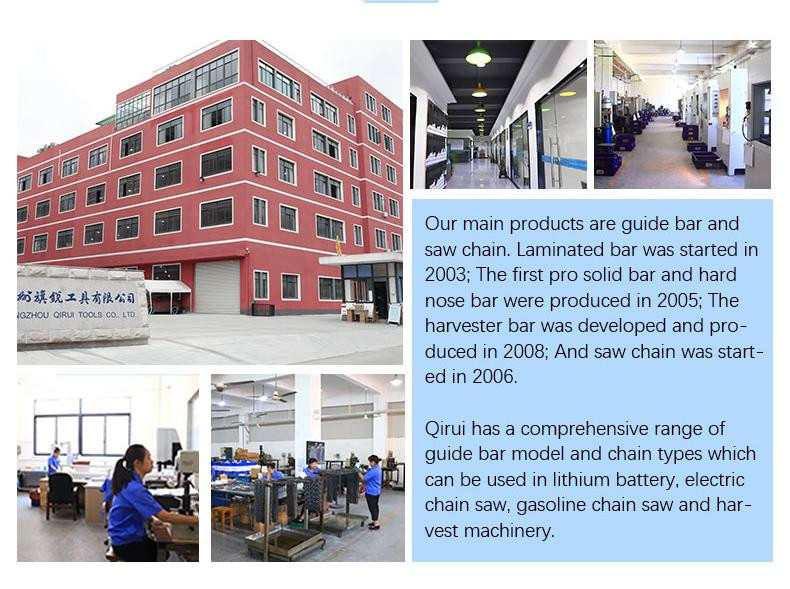Contact Us


News content

Chainsaw bars are fundamental components of any chainsaw, playing a crucial role in determining the tool's performance, efficiency, and versatility. Understanding the intricacies of chainsaw bars is essential for making an informed purchase decision, ensuring safety, and optimizing your cutting experience.
A chainsaw bar is the elongated guide that supports the cutting chain and dictates the cutting length. It serves as the foundation upon which the chain rotates, enabling precise and efficient cutting across various materials. These bars come in different lengths, materials, and designs, catering to diverse cutting needs.
Comprehending the anatomy of a chainsaw bar aids in selecting the right one for your specific applications. It typically comprises the following components:
Guide Bar: The main body of the bar that houses the chain.
Nose: The tip of the bar that determines the precision of cutting in tight spaces.
Groove: A channel where the chain teeth glide through, facilitating smooth cutting motions.
Mounting Holes: Points for securing the bar to the chainsaw body.

Understanding the different types of chainsaw bars available in the market empowers buyers to make informed decisions based on their cutting requirements and preferences.
These bars are the conventional choice for regular cutting tasks. They come in various lengths, suitable for both occasional users and professionals. Standard bars offer a balance between cutting capacity and maneuverability, making them versatile for a wide range of applications.
Solid nose bars feature a solid tip at the end of the bar, enhancing durability and precision during cutting. They are preferred for heavy-duty applications, especially in challenging environments or when cutting hardwoods, where accuracy and strength are paramount.
Laminated bars are lighter and more maneuverable due to their construction, employing layers of metal to form the bar. Sprocket nose bars have a replaceable sprocket tip, allowing for easy maintenance and cost-effective repairs.
Carving bars are designed for intricate and detailed woodwork, catering to artisans and craftsmen. These shorter bars offer increased precision and control, enabling users to create intricate designs and sculptures effectively.
Several crucial factors determine the suitability of a chainsaw bar for specific tasks. Understanding these factors is vital for selecting the most appropriate bar for your cutting needs.
The length of the bar significantly impacts cutting capacity and maneuverability. Longer bars excel in cutting larger diameters but may be cumbersome for intricate tasks. Conversely, shorter bars offer increased control but have limitations in cutting thicker materials.
Gauge refers to the thickness of the drive links on the chain, while pitch measures the distance between three consecutive rivets divided by two. Matching the bar gauge and pitch with the chainsaw chain ensures optimal performance and safety during operation.
Chainsaw bars are commonly made from steel or lightweight alloys. Understanding the pros and cons of different materials aids in choosing a bar that balances durability, weight, and performance based on your cutting requirements.

Proper maintenance of your chainsaw bar is essential to prolong its lifespan and ensure safe and efficient operation.
Frequent cleaning of the bar groove and proper lubrication of the chain reduce friction, preventing premature wear and heat buildup. This maintenance routine also enhances cutting efficiency and extends the life of both the bar and the chain.
Maintaining proper chain tension is crucial for safe operation. Regularly check and adjust the chain tension to prevent slippage or excessive wear on the bar.
Periodically inspect your chainsaw bar for signs of wear, such as bar rail damage or elongation. Replace worn-out bars promptly to avoid compromising safety and cutting performance.

Safety should always be a top priority when operating a chainsaw. Adhering to essential safety precautions minimizes the risk of accidents and ensures a secure working environment.
Wear appropriate PPE, including a helmet, eye protection, gloves, and sturdy clothing, to safeguard against potential injuries from flying debris or accidental contact with the chainsaw.
Learn and apply correct chainsaw handling techniques to maintain control and reduce the likelihood of accidents. Always hold the chainsaw firmly with both hands and maintain a stable stance while cutting.
Before commencing any cutting operation, survey the working area for potential hazards such as obstacles, uneven terrain, or entangled materials that may interfere with the cutting process.
A comprehensive understanding of chainsaw bars is pivotal for making informed purchasing decisions and ensuring safe and efficient cutting operations. By considering factors like bar type, length, maintenance, and safety precautions, users can maximize the performance and longevity of their chainsaw bars while minimizing risks associated with their use.
Remember, the right chainsaw bar, coupled with proper maintenance and safety measures, not only enhances cutting efficiency but also contributes significantly to a safer working environment.
More
When it comes to cutting power and efficiency, having the right tools can make all the difference. If you're looking for a guide bar that can maximize your cutting power, then the 880 Long Chainsaw Guide Bar is a perfect choice.
Choosing the right saw bar is crucial for achieving the best results in wood cutting. Your saw bar is your tool for shaping wood according to your needs. Make the right choice for optimal outcomes.
When it comes to tackling heavy-duty cutting tasks, a long chainsaw guide bar can be a valuable tool for both professional loggers and homeowners. These guide bars, which are longer than the standard ones, offer several advantages and benefits.
More
Email: qirui@qiruibar.com
Tel:0086-571-82308666
Add: No. 390, Xiangdafang Industrial Park, Wenyan Street, Xiaoshan District,Hangzhou,Zhejiang,China
Website: www.qiruibar.com



Contact Us
Contact Us
